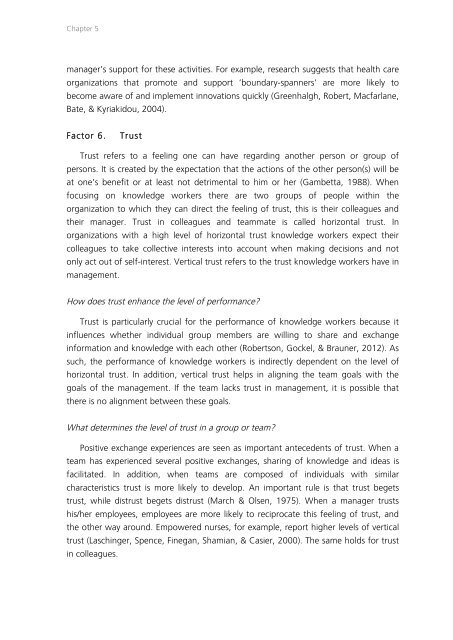In Search of Evidence
jqluvth
jqluvth
You also want an ePaper? Increase the reach of your titles
YUMPU automatically turns print PDFs into web optimized ePapers that Google loves.
Chapter 5<br />
manager’s support for these activities. For example, research suggests that health care<br />
organizations that promote and support ‘boundary-spanners’ are more likely to<br />
become aware <strong>of</strong> and implement innovations quickly (Greenhalgh, Robert, Macfarlane,<br />
Bate, & Kyriakidou, 2004).<br />
Factor 6.<br />
Trust<br />
Trust refers to a feeling one can have regarding another person or group <strong>of</strong><br />
persons. It is created by the expectation that the actions <strong>of</strong> the other person(s) will be<br />
at one’s benefit or at least not detrimental to him or her (Gambetta, 1988). When<br />
focusing on knowledge workers there are two groups <strong>of</strong> people within the<br />
organization to which they can direct the feeling <strong>of</strong> trust, this is their colleagues and<br />
their manager. Trust in colleagues and teammate is called horizontal trust. <strong>In</strong><br />
organizations with a high level <strong>of</strong> horizontal trust knowledge workers expect their<br />
colleagues to take collective interests into account when making decisions and not<br />
only act out <strong>of</strong> self-interest. Vertical trust refers to the trust knowledge workers have in<br />
management.<br />
How does trust enhance the level <strong>of</strong> performance?<br />
Trust is particularly crucial for the performance <strong>of</strong> knowledge workers because it<br />
influences whether individual group members are willing to share and exchange<br />
information and knowledge with each other (Robertson, Gockel, & Brauner, 2012). As<br />
such, the performance <strong>of</strong> knowledge workers is indirectly dependent on the level <strong>of</strong><br />
horizontal trust. <strong>In</strong> addition, vertical trust helps in aligning the team goals with the<br />
goals <strong>of</strong> the management. If the team lacks trust in management, it is possible that<br />
there is no alignment between these goals.<br />
What determines the level <strong>of</strong> trust in a group or team?<br />
Positive exchange experiences are seen as important antecedents <strong>of</strong> trust. When a<br />
team has experienced several positive exchanges, sharing <strong>of</strong> knowledge and ideas is<br />
facilitated. <strong>In</strong> addition, when teams are composed <strong>of</strong> individuals with similar<br />
characteristics trust is more likely to develop. An important rule is that trust begets<br />
trust, while distrust begets distrust (March & Olsen, 1975). When a manager trusts<br />
his/her employees, employees are more likely to reciprocate this feeling <strong>of</strong> trust, and<br />
the other way around. Empowered nurses, for example, report higher levels <strong>of</strong> vertical<br />
trust (Laschinger, Spence, Finegan, Shamian, & Casier, 2000). The same holds for trust<br />
in colleagues.


